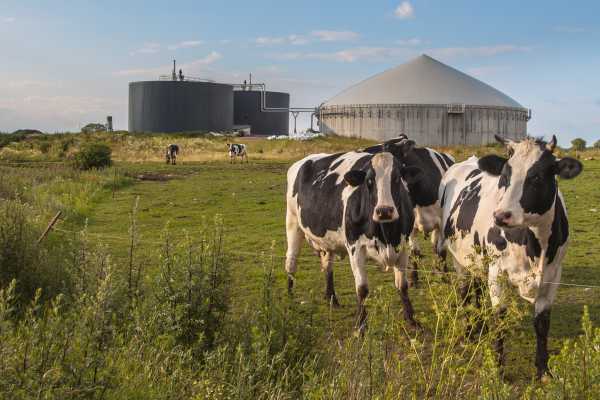
This piece was originally published on February 14 and has been updated to include a comment from SoCalGas.
To stay in line with the targets laid out in the Paris climate agreement, the US needs to reach net-zero carbon emissions by 2050, known as “deep decarbonization.” Virtually every credible study on deep decarbonization agrees on the basics of a strategy to get there.
The heart of the strategy is cleaning up the power grid, which is currently responsible for 28 percent of US greenhouse gas (GHG) emissions. It must be rapidly transitioned to zero-carbon sources like renewables, hydro, and nuclear.
Concurrently, two of the biggest sources of GHGs, transportation and buildings, must switch over to run on that zero-carbon power. The transportation system (29 percent of US emissions) is almost entirely powered by gasoline and diesel; it must transition to electric vehicles to the extent possible. And buildings (also 29 percent of US emissions) are now frequently heated and cooled by oil or, more commonly, by natural gas; they must transition to electric heating and cooling to the extent possible.
This strategy — for which I use the shorthand “electrify everything!” — is beginning to catch on, especially in California, which is always something of a preview of broader trends to come. In a relatively short span of time, a robust “all-electric movement” has emerged, as dozens of towns and cities take steps to encourage all-electric construction in new buildings.
Natural gas utilities do not like this movement one bit. The more all-electric buildings there are, the fewer natural gas ratepayers there are. An all-electric future inevitably involves the obsolescence, or at least the substantial diminution, of natural gas utilities. Naturally, they are fighting back furiously, with astroturf groups, PR campaigns, and lobbying at the local level.
Their main argument — playing out with particular intensity in California — has to do with “renewable natural gas” (RNG), an industry term for methane captured from biogenic (organic) waste at landfills, livestock operations, farms, and sewage treatment facilities. (It is sometimes called “biogas” or “biomethane.”)
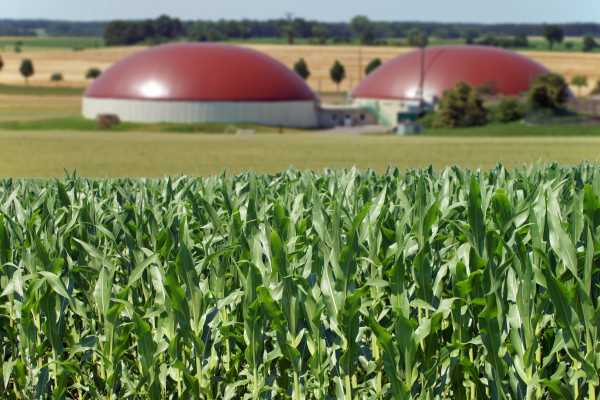
RNG can, depending on feedstock and circumstances, be low or even zero-carbon.
Utilities like SoCalGas argue that ramping up the production of RNG and blending it with normal natural gas in pipelines can reduce GHGs faster and cheaper than electrifying buildings. According to Southern California Gas Company spokeswoman Christine Detz, “A growing number of experts and industrialized nations recognize the need to include renewable gases as part of a sustainable energy mix.”
By pursuing electrification, they say, regulators are pushing unnecessary cost hikes onto consumers.
It would be nice for the utilities if this were true. But it’s not. RNG is not as low-carbon as the industry claims and its local air and water impacts are concentrated in vulnerable communities. Even if it were low-carbon and equitable, there simply isn’t enough of it to substitute for more than a small fraction of natural gas. And even if it were low-carbon, equitable, and abundant, it still wouldn’t be an excuse to expand natural gas infrastructure or slow electrification.
It isn’t a close call. The research is clear: Especially in a temperate climate like California, RNG is not a viable alternative for decarbonizing buildings. It is a desperate bid by natural gas utilities to delay their inevitable decline. Policymakers would be foolish to fall for it.
That’s the short version. Now let’s look at how the battle is playing out, with an emphasis on California, which is one of the country’s top natural gas-consuming states — and a state with a goal of going net-carbon-zero by 2050.
Electrification is gaining serious momentum in California
The expert chorus supporting electrification has been getting louder.
Energy efficiency and electrification are recommended for the building sector in the United States Mid-Century Strategy for Deep Decarbonization, developed under the Obama administration. They are recommended throughout the work of the Deep Decarbonization Pathways Project (DDPP) on various countries, including the US. (DDPP also did a pathways analysis for my home state of Washington, at Gov. Jay Inslee’s behest; it contains the same recommendations.)
The California Energy Commission (CEC) has done a report on deep decarbonization and a (recently updated) extensive report on the future of the state’s natural gas network. In both reports, it finds that electrification is the cheapest option for decarbonizing buildings.
In response to this chorus, 26 California cities have now either passed an ordinance phasing out natural gas in new building construction or updated building codes to encourage all-electric construction. Dozens more cities are expected to follow suit this year. Across the state, builders and real estate developers are being pressured by their investors about “carbon risk,” the possibility of building fossil fuel-reliant assets that will be unable to find buyers.
Perhaps most significantly, in January, the California Public Utilities Commission (CPUC) announced a new proceeding to begin the process of weaning the state off of natural gas, including consideration of a just transition to avoid safety issues and stranded costs.
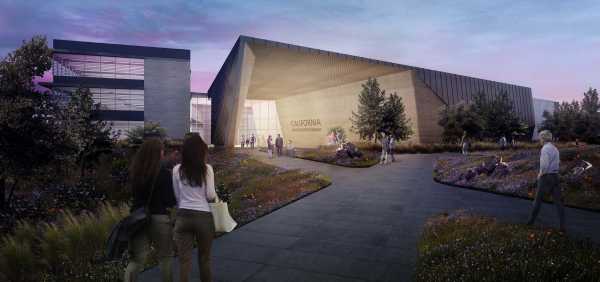
Natural gas utilities are freaking out and getting shady
All this momentum has thoroughly freaked out the Southern California Gas Company, the nation’s largest gas utility, serving 5.7 million customers in Southern and Central California. SoCalGas makes more yearly revenue than any other utility in the nation, and of its $2.9 billion in revenue in 2018, $2.25 billion, almost 80 percent, came from residential customers. All-electric residential construction would crush it.
Monopoly natural gas utilities run the same way monopoly electricity utilities do. They don’t make money on the sale of gas. Rather, they charge a rate for gas that is meant to cover their costs, the costs of new investments in natural gas infrastructure, and a healthy fixed rate of return on those investments. In other words, they make profits by building stuff. Naturally, they want to build more stuff.
But what they are facing is a steady loss of demand, as more and more customers opt out of the natural gas system in favor of the grid. That will leave fewer and fewer customers paying higher and higher rates just to maintain the existing pipeline infrastructure, with little room left for new investments.
This is a disaster in the offing for SoCalGas and its owner, Sempra Energy. A few years ago, a new nonprofit was born: Californians for Balanced Energy Solutions (C4Bes). It began running ads opposing a natural gas phaseout and lobbying local lawmakers across the state, using apocalyptic messaging about the cost to consumers, recruiting local signatories for petitions against electrification. In March 2017, it had the unbridled chutzpah to ask the CPUC to make it an official party in the proceeding regarding the future of natural gas in the state.
That prompted the Sierra Club to point out, in a filing to the CPUC (replete with backing documents and leaked emails), that C4Bes is an astroturf group, a lobbying effort masquerading as a nonprofit. It’s a creation of SoCalGas, using talking points written by SoCalGas to organize opposition to municipal efforts that would negatively impact SoCalGas. It should not be posing as an independent party in a regulatory proceeding.
Finally, after months of parrying and delaying regulators, rather than face discovery, which would open up its books, C4Bes elected in January 2019 to withdraw from the proceeding. In May 2019, the Public Advocates Office, a consumer watchdog within the CPUC, determined that SoCalGas had been using sleazy tactics, including, reports KQED, “lying to regulators, undermining efficiency codes and standards, and ‘astroturfing’: funding a seemingly independent advocacy group with ratepayer money.” It recommended that CPUC sanction the utility.
Michael Boccadoro, head of Dairy Cares, an advocacy group for animal agriculture in California, was originally on the board of C4Bes until he saw their tactics up close — telling homeowners that government agents would be ripping out their gas stoves soon, crematoria that would no longer be able to cremate bodies, and Asian restaurants that have to give up their woks. “It’s pretty misleading what they’re trying to do,” he says, “and the story they’re out there telling. It seems like a desperate action.” He resigned from the board last year.
(For more on this, see scathing stories from Susie Cagle at the Guardian and Michael Hiltzik at the LA Times, along with an LA Times editorial.)
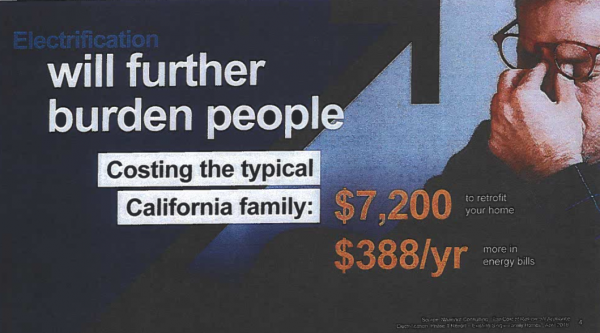
C4Bes withdrew from the proceeding, but it is still active, still out telling municipal officials horror stories about electrification. And it is not alone. In the Pacific Northwest, a coalition of gas utilities has launched a $1 million PR effort to push back against electrification in the region. “Partners for Energy Progress” will use much of the same messaging that C4Bes is using.
That means two things: raising fears about the costs of a transition (despite a broad consensus that electrification will save consumers money, as we will see later) and stressing consumer “choice.” They know from their research that they can’t get away with simply opposing decarbonization. They need an “all of the above” message, one that offers consumers a choice of different decarbonization pathways.
That’s the role RNG is playing in this debate: The natural gas industry is proposing it as a choice, an alternate route to decarbonization.
Is it?
There isn’t enough RNG to go around
The main question facing RNG is simple: Is there enough of it to decarbonize existing uses of natural gas, like buildings? Several states have looked into this closely. The answer, in a word, is no.
In its deep decarbonization pathways study, the CEC concluded that, if California had access to its population-weighted share of total US bioenergy output, “there appears to be insufficient biomethane to displace the necessary amount of building and industry fossil natural gas consumption to meet the state’s long-term climate goals.”
UC Davis also did a study on the potential of RNG in California. It found that, all told, about 82 billion cubic feet a year (bcf/y) of biomethane sources are “attractive for investment,” taking into account state and federal incentives. By way of comparison, in 2017, California consumed about 2,110 bcf/y of natural gas. So under the most optimistic assumptions, RNG could replace 4.1 percent of California’s gas demand (1.6 percent on the low end of estimates).
What about RNG for transportation, another idea that the natural gas industry has long supported? A 2017 report from the Union of Concerned Scientists showed that it would require almost the entire country’s RNG potential to replace diesel fuel alone in California.
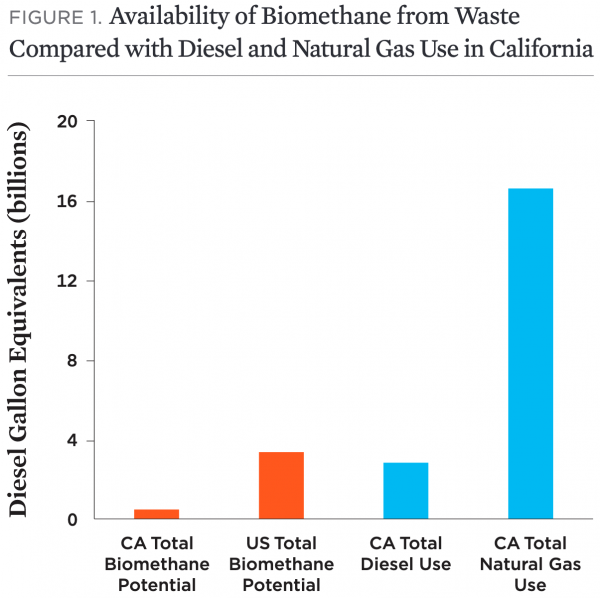
In 2013, the National Renewable Energy Laboratory (NREL) concluded that the total potential for biogas in the US (excluding energy crops) is about 431 trillion BTUs. In 2015, California used about 1.6 quadrillion BTUs in its buildings. So if the entire country’s biogas potential were devoted to California buildings and nothing else, it would replace about a quarter of the gas used.
Long story short: There literally isn’t enough RNG in the US to decarbonize California buildings.
A Washington State University study done for the Washington Department of Commerce found something similar for that state: “adequate opportunities exist for RNG production equivalent to 3 percent to 5 percent of current natural gas consumption in Washington.”
A study by the Oregon Department of Energy found that if the state maximized its domestic resources, it could replace between 10 and 20 percent of its natural gas use with RNG.
Finally, a more optimistic study by the gas industry itself found that, if RNG is combined with synthetic natural gas (SNG) made from electrolyzed hydrogen and captured carbon, it could replace 6 to 13 percent of the US demand for pipeline gas by 2040.
There is no credible study anywhere claiming that RNG can fully decarbonize the natural gas system, by California’s 2045 deadline or ever.
RNG is extremely costly compared to alternatives
Gas utilities are proposing to increase RNG in their pipelines and to charge their customers for the extra expense through rate hikes. SoCalGas has pledged 20 percent RNG by 2030 (it proposes to raise rates 30 percent between 2018 and 2022).
“As California charts its path toward carbon neutrality some have suggested that electrification is the silver bullet to get us there,” SoCalGas’s Detz told Vox. “But the science is clear, electrification alone is not a pathway for getting to carbon neutral.
“SoCalGas is committed to becoming the cleanest gas utility in North America,” she added.
In the Pacific Northwest, NW Natural, a large gas utility in Oregon, has pledged 30 percent emissions reductions from 2015 levels by 2035 (it proposes to hike rates by $2.50 to $3 a month per customer).
While RNG is a promising development and may be useful in some sectors (see below), there is no justification for blending it in pipelines as a way to decarbonize the building sector. For buildings, electric alternatives are available and cheaper.
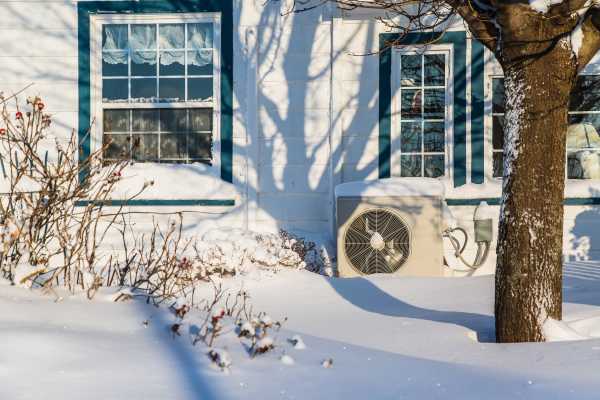
Before demonstrating that, it’s worth addressing a particular study that gas utilities and their allies like to cite. It was done by research consultancy Navigant at the behest of SoCalGas. It selects the highest possible estimates of electrification costs and the lowest possible estimates of RNG costs, ignores pipeline leaks, ignores local health and equity impacts, and ignores the sustainability of RNG feedstocks.
But more importantly, it compares the total GHG reductions of RNG blended in the natural gas supply (which would marginally reduce the emissions of all natural gas uses in all sectors) with reductions through electrification in the building sector alone. That’s not an apples-to-apples comparison. The question is not the best way to get a third of the way to zero by 2030, as the study does; it’s the best way to get all the way to zero.
As we’ve seen, while natural gas supply might be partially decarbonized with RNG (say, 15 percent, being maximally generous), there is not enough RNG to get it to net zero, which is the ultimate destination. There’s no point going down a pathway that ends in a cul de sac in a few years; there’s no time.
Other, less biased studies look worse for RNG.
A deep decarbonization study for California done by Energy & Environmental Economics (E3) found that electrification was the most predictable and cost-effective way to decarbonize buildings, given limits on RNG supply.
In a 2017 report examining California’s program of supportive tariffs for bioenergy (from landfills, ag operations, and forest wastes), the CPUC observed that the cost of the tariffs is “disproportionately high compared with other renewable procurement options” and that there is “no indication of market transformation” that might bring costs down in the future.
“Digesters are steel and cement, and some plastic,” says Boccadoro. “Those are not going to come down [in price]; they’re going to continue to increase.” What’s more, the easiest and most suitable sites for biomethane capture are developed first, which means projects become more difficult and expensive as time progresses — the opposite of economies of scale.
Another E3 study on the future of natural gas distribution in California found that, even with “aggressive technology learning,” the RNG needed to decarbonize the state’s natural gas system would be both wildly expensive and insufficient. It would have to be supplemented by heroic amounts of hydrogen and synthetic natural gas from out of state.
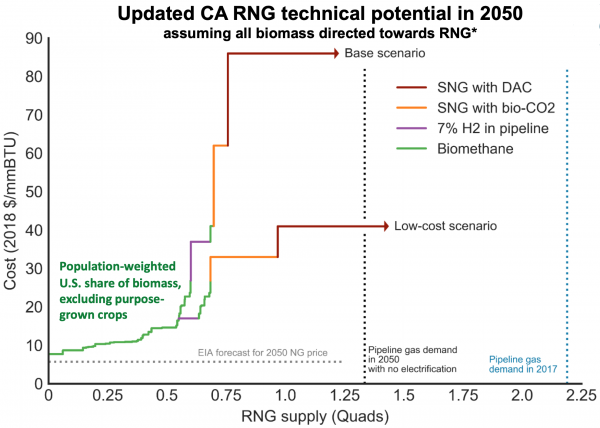
If RNG (or SNG) comes from out of state, then it is out of state where the emission reduction occurs. “We keep claiming [RNG] is going to ‘decarbonize’ the gas system,” Boccadoro says, “but it doesn’t really decarbonize the gas that’s being burned. There’s some offset occurring somewhere else, and when that offset occurs outside of California, it doesn’t help reduce our emissions here in California.”
What’s more, shifting to RNG (and SNG) would radically drive up gas costs. No policymaker or regulator in their right mind is going to ask a shrinking group of natural gas ratepayers to pay these exorbitant costs. “I represent some of the largest gas users in the state,” Boccadoro says. “We can’t afford to pay seven times what our competition is paying for natural gas.”
Notably, the study also found that in all scenarios, high and low electrification, total gas “throughput” declined. There is no decarbonization scenario where natural gas use increases.
Another more recent E3 study looked at the economics of residential building electrification in California and found that it would represent a savings, not a cost, relative to the status quo. For new construction, an all-electric home saves between $130 and $540 a year relative to one that burns gas. Single-family homes that retrofit from natural gas to all-electric save between $10 and $60 a month on energy bills. And those savings increase over time as electricity gets cheaper and cleaner and natural gas rates continue rising.
A Synapse Energy study found that even though electric heat pumps still cost more than natural gas furnaces, for new construction, opting for a heat pump saves $1,500 up front, thanks to the avoided costs of plumbing the property for gas.
The Rocky Mountain Institute did a report on the economics of all-electric, zero-net-energy homes, which are already far more favorable than widely understood. In San Francisco, such homes pay their extra upfront costs back within eight years.
To summarize: decarbonizing buildings with electrification saves homeowners and developers money, with savings rising over time; decarbonizing buildings with RNG costs ratepayers money, with costs rising over time.
And that’s just costs. There are other impacts of RNG to consider.
RNG exacerbates air pollution problems
Once it is captured from organic sources and injected into pipelines, RNG is chemically identical to natural gas. Methane is methane. It has all the same effects when leaked or combusted.
Methane is a potent greenhouse gas — 28 to 36 times more potent than CO2 over 100 years — and represents 9 percent of California’s total GHG emissions. It is also a local air pollutant.
Among other things, it pollutes indoor air when used for cooking. A 2017 CARB study found that “cooking emissions, especially from gas stoves, have been associated with increased respiratory disease.” A raft of peer-reviewed research (see here and here) shows that cooking with gas elevates risk for those in the home, especially for vulnerable populations like children. As many as 12 million Californians are exposed.
The natural gas industry has pushed for RNG to be used in heavy trucks in place of diesel, but a 2012 study found that, if the leakage rate in natural gas pipelines is any greater than 1.4 percent, the climate benefits of switching from diesel to RNG are negated. A recent literature review found that the leakage rate in California is somewhere between 2.4 and 4.3 percent.
Even if there were no leakage, the combustion of methane in a vehicle emits carbon dioxide, carbon monoxide, and nitrogen oxides.
RNG is also produced by sources that are themselves big polluters. Despite what the rosy term “renewable” might suggest, the CEC found that the state’s two biggest sources of biogas are landfills and manure from factory farms.
It’s better to capture some of the gas from landfills and factory farms than to let it escape into the atmosphere. (Boccadoro says manure methane emissions in California have declined by 25 percent in the last four years.) But it’s odd to think of those polluting sources as “renewable.” Many people hope they will decline over time, as Americans generate less food waste and eat a healthier diet with less red meat and dairy.
Small farms, with pasture-grazed cows, generate no appreciable methane. It’s the big, industrial dairy farms that are responsible for 55 percent of the state’s methane emissions. As the California Department of Food and Agriculture (CDFA) has handed out subsidies for biodigesters, the average herd size of a recipient is 7,430 head. By way of comparison, average herd size in Wisconsin, the second-largest dairy state, is 134 head. These are huge operations. And they must be, to justify capturing methane; a 2018 study found that 3,000 head is the minimum herd size needed to make anaerobic digestion economic.
Anaerobic digesters also leak methane, at a rate of between 2 and 3 percent, adding to their lifecycle GHGs in a way that is rarely captured in models.
For now at least, to the extent that decarbonization is linked to RNG, it is reliant on a steady supply of landfills and factory farms, which produce the very sort of pollution that electrification eliminates. A study last year in Environmental Science & Technology summed up the difference for California:
The sun and wind are healthier sources of energy than trash and shit.
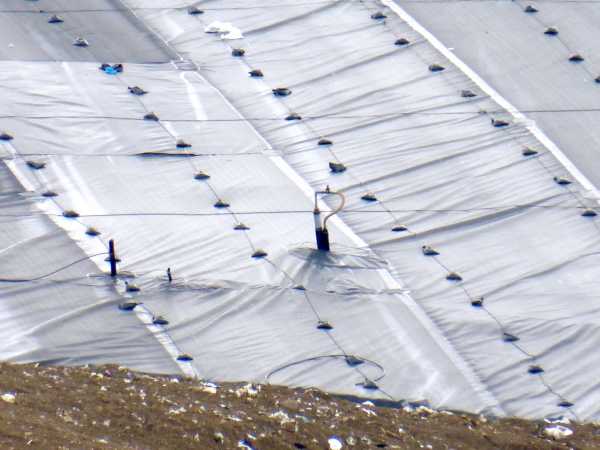
RNG impacts are concentrated in vulnerable communities
The industrial dairy farms that produce RNG are mostly located in the San Joaquin Valley, one of the poorest areas of the state, where African Americans, Latinos, and Native Americans make up the majority of the population. It is home to the nation’s worst air pollution, the highest rate of asthma in children, and nitrate-laced drinking water.
Livestock operations are the top source of ozone-causing pollutants in the area, a major source of nitrate pollution, and a major source of ammonia emissions, which cause eutrophication of surface water and fine particulate pollution. They also release persistent odors that cause headaches.
Residents of the area have been pushing the state government to stop subsidizing harmful agriculture and livestock management and start subsidizing regenerative and other climate-friendly agricultural practices. But the state still devotes a far smaller amount to those practices than to dairy digesters — $21.6 million versus $72.4 million.
California’s pioneering law SB 1383 requires that the state reduce methane pollution from organic waste 40 percent by 2030; it does not require that it capture 40 percent of methane. It can just as easily, often less expensively, reduce the waste streams that produce the methane. But if RNG is made into a valuable commodity, it will bias the industry (and the lawmakers it lobbies) to seek expanded dairy operations.
Residents of the San Joaquin Valley reasonably worry that a major new source of revenue for industrial dairy farms will help support an otherwise economically marginal industry, perhaps even encourage its growth, and that their children will pay the hidden costs.
RNG is worth pursuing, but not as an alternative to electrification
None of the above should be taken as arguing against RNG, provided that protections for vulnerable communities are built in. As long as there are landfills, giant manure ponds, agriculture and forestry waste, and sewage treatment plants off-gassing methane into the atmosphere, it makes sense to capture as much of that methane as possible and use it. It’s better than fracking it out of the ground.
And there are plenty of good ways to put RNG to use.
I’ve mostly focused on California in this post, but it’s worth pointing out that in other, less temperate states, the electricity system faces higher seasonal peaks, as everyone turns on heaters or air conditioners at once. Adding both cars and all remaining buildings to already congested grids could threaten their reliability. Many states, like the densely populated states of the Northeast US, will need much longer than California to prepare, to build their grids out and learn how to manage all that new electricity demand. Until then, RNG could work in the background to lower the carbon intensity of natural gas.
And it may be that there are some sectors of the economy that resist electrification and still need combustible liquid fuels even through 2050 — so-called “harder-to-abate” sectors like shipping, aviation, or heavy industry. It’s better for those sectors to burn RNG (and SNG) than to burn fracked gas.
There are also lots of vehicles already in circulation that could benefit from RNG. Recently, UPS bought a bunch of RNG to reduce the climate impact of its existing fleet of natural-gas trucks. But even UPS is realistic:
Liquid fuels will probably be needed for various subsectors and niche applications for a long while, so it’s worth pursuing every promising carbon-neutral or carbon-negative fuel.
But there are two key points to emphasize here. First, there is no scenario in which RNG is an alternative to electrification. At best, it is a complement. Electrification should move full speed ahead no matter what happens with RNG.
Second, California buildings are not one of those harder-to-abate sectors that need liquid fuels. A study last year in the journal Atmosphere specifically compared various pathways to decarbonizing space and water heating in California buildings, including “solar thermal, biogas, synthetic natural gas, and electrification.” It found that electrification is the only alternative that can serve all heating loads in the state (others cover between 2 and 70 percent). What’s more, it is the least cost pathway, coming in at 25 to 90+ percent cheaper than the alternatives.
The study concludes: “[E]nergy efficiency with electrification of heating is the most likely path to achieve the large carbon emission reduction needed from this sector.”
RNG cannot delay the inevitable decline of natural gas
Make no mistake, the natural gas industry opposes electrification because it wants to expand pipeline infrastructure. At an American Gas Association meeting in 2018, one industry leader, discussing RNG, tasked the audience to “consider how technologies to decarbonize the pipeline can serve as a conduit to environmental organizations, thereby seeking to mitigate the opposition’s fervor against infrastructure expansion.”
But the development of RNG, while worth pursuing, does not mean what SoCalGas and other natural gas utilities want it to mean. It is no reason to expand gas infrastructure; the fervor is as warranted as ever.
A recent report from E3G examined the role of natural gas in the EU’s decarbonized future. It found that in all its scenarios, even the most generous to decarbonized gas, the total amount of natural gas “throughput” in the system declined. It concluded that RNG should be pursued, but because it is so expensive, it should be targeted at harder-to-abate sectors where it has the highest social value. Above all, “the future prospect of renewable and decarbonised gases is no reason to slow down electrification or efficiency at this stage.”
The same is true in the US, as virtually every study agrees. Deep decarbonization means the decline of the natural gas industry, no matter what happens with RNG or SNG.
As the CEC has concluded, allowing the decline of natural gas to unfold organically threatens to be an unnecessarily long and messy process, leaving the growing costs of maintaining natural gas infrastructure piled on the shoulders of a shrinking group of ratepayers, largely those who can’t afford to escape the system. The only responsible course of action at this point is the one the CPUC appears to be taking: planning for a deliberate phaseout of natural gas, with costs shared equitably.
RNG is an interesting development at the margins, for some energy applications. But it is no bigger than a blip in the larger story of natural gas, which is one of inexorable and inevitable fading away to the margins.
Sourse: vox.com





